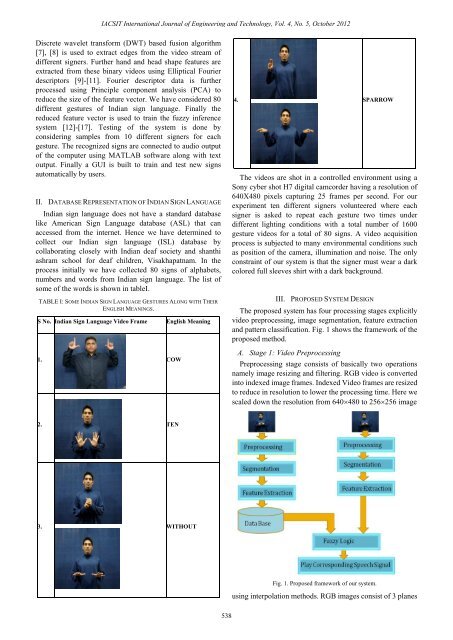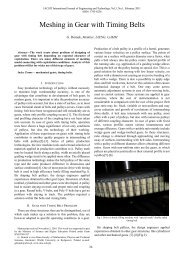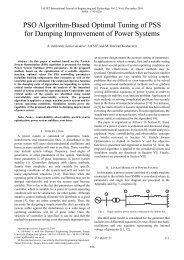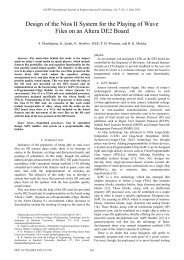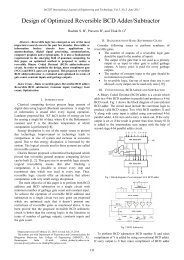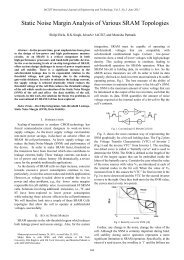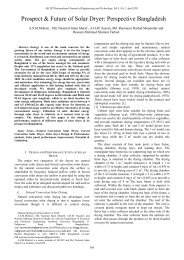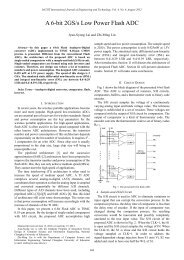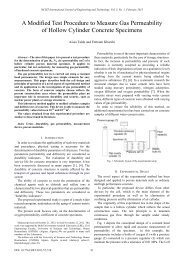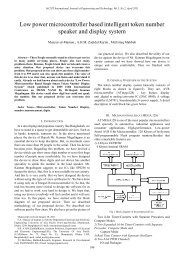A Video Based Indian Sign Language Recognition System ... - IJET
A Video Based Indian Sign Language Recognition System ... - IJET
A Video Based Indian Sign Language Recognition System ... - IJET
Create successful ePaper yourself
Turn your PDF publications into a flip-book with our unique Google optimized e-Paper software.
IACSIT International Journal of Engineering and Technology, Vol. 4, No. 5, October 2012<br />
Discrete wavelet transform (DWT) based fusion algorithm<br />
[7], [8] is used to extract edges from the video stream of<br />
different signers. Further hand and head shape features are<br />
extracted from these binary videos using Elliptical Fourier<br />
descriptors [9]-[11]. Fourier descriptor data is further<br />
processed using Principle component analysis (PCA) to<br />
reduce the size of the feature vector. We have considered 80<br />
different gestures of <strong>Indian</strong> sign language. Finally the<br />
reduced feature vector is used to train the fuzzy inference<br />
system [12]-[17]. Testing of the system is done by<br />
considering samples from 10 different signers for each<br />
gesture. The recognized signs are connected to audio output<br />
of the computer using MATLAB software along with text<br />
output. Finally a GUI is built to train and test new signs<br />
automatically by users.<br />
II. DATABASE REPRESENTATION OF INDIAN SIGN LANGUAGE<br />
<strong>Indian</strong> sign language does not have a standard database<br />
like American <strong>Sign</strong> <strong>Language</strong> database (ASL) that can<br />
accessed from the internet. Hence we have determined to<br />
collect our <strong>Indian</strong> sign language (ISL) database by<br />
collaborating closely with <strong>Indian</strong> deaf society and shanthi<br />
ashram school for deaf children, Visakhapatnam. In the<br />
process initially we have collected 80 signs of alphabets,<br />
numbers and words from <strong>Indian</strong> sign language. The list of<br />
some of the words is shown in tableI.<br />
TABLE I: SOME INDIAN SIGN LANGUAGE GESTURES ALONG WITH THEIR<br />
ENGLISH MEANINGS.<br />
S No. <strong>Indian</strong> <strong>Sign</strong> <strong>Language</strong> <strong>Video</strong> Frame<br />
1. COW<br />
English Meaning<br />
4. SPARROW<br />
The videos are shot in a controlled environment using a<br />
Sony cyber shot H7 digital camcorder having a resolution of<br />
640X480 pixels capturing 25 frames per second. For our<br />
experiment ten different signers volunteered where each<br />
signer is asked to repeat each gesture two times under<br />
different lighting conditions with a total number of 1600<br />
gesture videos for a total of 80 signs. A video acquisition<br />
process is subjected to many environmental conditions such<br />
as position of the camera, illumination and noise. The only<br />
constraint of our system is that the signer must wear a dark<br />
colored full sleeves shirt with a dark background.<br />
III. PROPOSED SYSTEM DESIGN<br />
The proposed system has four processing stages explicitly<br />
video preprocessing, image segmentation, feature extraction<br />
and pattern classification. Fig. 1 shows the framework of the<br />
proposed method.<br />
A. Stage 1: <strong>Video</strong> Preprocessing<br />
Preprocessing stage consists of basically two operations<br />
namely image resizing and filtering. RGB video is converted<br />
into indexed image frames. Indexed <strong>Video</strong> frames are resized<br />
to reduce in resolution to lower the processing time. Here we<br />
scaled down the resolution from 640480 to 256256 image<br />
2. TEN<br />
3. WITHOUT<br />
Fig. 1. Proposed framework of our system.<br />
using interpolation methods. RGB images consist of 3 planes<br />
538


